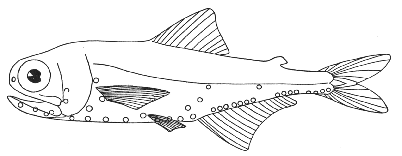Lanternfish Myctophum affine (Lütken) 1892
Description—
The most noticeable features of this little oceanic fish are its silvery black color, the luminous dots along its sides, its enormous eye situated close to the tip of the snout, its very deep oblique mouth, and its deeply forked tail. The anal fin is mostly or wholly behind the short, soft dorsal, and there is an adipose fin behind the latter, as in the headlightfish (p. 142). The longer snout and smaller mouth of Myctophum, with the fact that the luminous organs on its snout are in the form of small dots instead of a large patch covering the entire tip of the snout, are the readiest field marks to distinguish it from the latter. The dorsal profile of the head is much arched, the body moderately flattened sidewise, tapering gently backward to the rather deep caudal peduncle. The location of the luminescent spots is shown in the drawing (fig. 61).
Color—
This lanternfish is silvery when alive, the silver underlain on the back with deep brownish black, the sides below the lateral line, and the belly varying (below the silver) from dark brown to dusky gray, or even to white finely dotted with gray. The luminescent organs are pale green or blue.
Size—
All members of the genus Myctophum are small; a little more than 3½ inches (89 mm.) is the maximum length recorded for this particular species.
General range—
All the species of this genus are oceanic, occurring only as strays inside the edge of the continent.
Occurrence in the Gulf of Maine—
Goode and Bean[30] report the capture of this lanternfish over the southeast slope of Browns Bank (lat. 42° 21' N., long. 65° 07' W.) at 104 fathoms, which still remains the only record for it in the Gulf of Maine,[31] or for any Myctophum for that matter.
[30] Smithsonian Contrib. Knowl. (vol. 30, 1895, p. 72) as M. opalinum.
[31] It is likely that Myctophum glaciale will be found in the Gulf of Maine sooner or later, judging from its widespread distribution in the boreal belt of the Atlantic and from the fact that it has often been caught at the surface. It resembles M. affine very closely in appearance, and in the general arrangement of the luminous organs, but differs from it in that one of the luminescent spots above the base of the ventral fin is elevated above the others.
